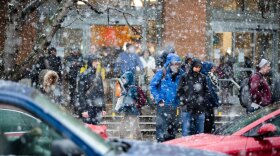Planning a trip this winter? Yes, it’s tempting to look for sunny spots where you can lie on a beach or play golf. But some of my favorite winter vacations have been to northerly destinations at their coldest, darkest times of year.
I don’t ski, so I’m not looking for powder. But I have seen northern lights in Alaska, explored an ice cave in Iceland, and stood outdoors in 20-degree weather watching migrating cranes in Nebraska.
I’ve been to Detroit in December, Canada for Christmas, Finland in February. And I’ve taken visitors around my hometown, New York City, in January, when holiday crowds are gone and prices are lower.
Here are some tips and ideas for planning a trip in the depths of winter.
Cities
There’s a reason New York City runs Restaurant Week prix fixe menus and 2-for-1 Broadway specials Jan. 16 to Feb. 4: It’s a way to drum up business at a slow time of year. Hotels and theater tickets also dip in price in January and February. Plus, you can get reservations that are otherwise impossible to score, and popular attractions have fewer crowds and shorter lines.
Weather can be mild on a sunny day in January in Manhattan, but bitter cold and snow are not unusual. While city streets are no fun to navigate covered in slush, consider that most of your time will be spent indoors visiting museums, seeing shows, shopping and eating your way around town.
Similar price-and-crowd patterns hold true for other northerly cities like Boston, Chicago and Montreal, though all three are typically colder and snowier than New York. So check forecasts, wear warm and waterproof boots, and save a bundle — on airfare, too — compared to trips in May or October.
Northern Lights
The northern lights flare on an 11-year cycle and 2024 is near the peak of that cycle. Of course, there are no guarantees you will see the aurora borealis, but at least this is a good year to try. Iceland, Alaska, and northern parts of Scandinavia and Canada are all good places for viewing, but do your research on weather data for cloud cover in specific destinations. You can’t see northern lights in cloudy skies.
When my son was 9, we flew to Fairbanks, Alaska, in February, checked out the ice-carving festival (this year, Feb. 17-March 31), then headed 60 miles north to Chena Hot Springs. The resort is its own little world; there’s no town, no cell service, limited Wi-Fi; and meals served with produce from greenhouses. We visited the resort’s ice museum, went dog sledding and snowmobiling, soaked in a geothermally heated outdoor pool, and yes, we saw the aurora.
City lights make it hard to see the northern lights, but on a recent trip to Reykjavik, Iceland, my husband and I simply drove our rental car to a waterfront walkway where people gather nightly to search the skies. The view there faces away from the city, and our detour paid off: We saw the aurora, albeit briefly.
Saunas and Ice Caves
Any trip you plan hoping to catch the northern lights should include other adventures. In Finland, you’ll want to visit Helsinki’s cozy cafes, plus Market Square and Old Market Hall, and, of course, saunas. Loyly Sauna is perched on the Baltic Sea, so dare to take a cold plunge in the icy waters while you’re there.
Just outside Helsinki, you can meet and feed reindeer at Nuuksio National Park, but for a real adventure, head north to Lapland and book a reindeer safari. While I haven’t done this, it appeals to my winter-loving soul: ice floating in Finland’s Oravi channel, dressed in a special “drysuit.”
Iceland is famous for its outdoor pools, heated by geothermal hot springs. (The famous Blue Lagoon is closed due to a nearby volcano, but authorities say the eruption’s impact is localized and that tourism and air travel elsewhere is unaffected.) I took a dip in the geothermal pool at the Secret Lagoon while driving Iceland’s famed Golden Circle route, which also includes Thingvellir National Park, Geysir (which is actually a field of geysers), and the stunning Gullfoss waterfall.
The highlight of our Iceland trip, though, was exploring an ice cave in Vatnajokull National Park. You must be accompanied by a registered guide, and it’s not an expedition for the faint of heart. Crampons attached to your boots give you the necessary traction to walk down a flight of stairs carved from sheer ice, and you spend an hour walking underground around a magical — but claustrophobic — frozen canal with walls of blue ice and icicle ceilings.
The cave was part of a two-day tour we took of the country’s South Coast that included otherworldly landscapes including glaciers, volcanoes, black-sand beaches and lagoons full of icebergs.
Western Wildlife
Many national parks in the northern U.S. close roads, lodges and other facilities in winter. But winter visitors to Yellowstone can stay in Old Faithful Snow Lodge or Mammoth Hot Springs Hotel and enjoy guided tours by snowmobile, snow coach, snowshoe or cross-country ski. It’s easier to see wolves in winter in Yellowstone than in summer; you might also see bison, elk, otters and other wildlife.
Birdwatching, too, can be a cold-weather pursuit. I took a chilly trip to Nebraska to see the sandhill crane migration. That’s when a half-million migrating birds stop to feed in the fields around the Platte River near the city of Kearney. The migration starts mid-February but peaks in mid-March. Guided tours are offered, but it’s also easy to access public viewing sites in Gibbon, Alda and Fort Kearny State Park.
Weather, Clothing and Packing
Temperatures vary tremendously in northern destinations, so do your homework. Winter temperatures in Reykjavik average in the 30s, comparable to New York, but elsewhere in Iceland, roads can suddenly be shut down by winter storms. Also, plan your days strategically based on sunrise and sunset. When my husband and I visited Iceland in late November, we left our hotel in total darkness at 8 a.m. to get to our first stop on the Golden Circle by 10 a.m., when the sun was finally visible.
Remember the old adage: There’s no such thing as bad weather — just bad clothing. For Iceland, all I needed to stay warm was a fleece under my parka. But for Fairbanks and Chena, I borrowed a full-body ski suit and bought used boots on eBay guaranteed for below-zero weather. By the way, N-95 or cloth masks from your pandemic supplies are a good way to keep faces warm in icy winds.
I regretted not bringing waterproof gloves to Iceland; it didn’t rain, but railings and ropes along steep paths were often wet with icy condensation.
One final tip: Long pants and thick socks take up more room in luggage than shorts and T-shirts. To conserve space, wear your boots on the plane. Pack everything else in plastic compression bags; you won’t believe how much less room your clothes take up once you seal those bags and squeeze the air out.






